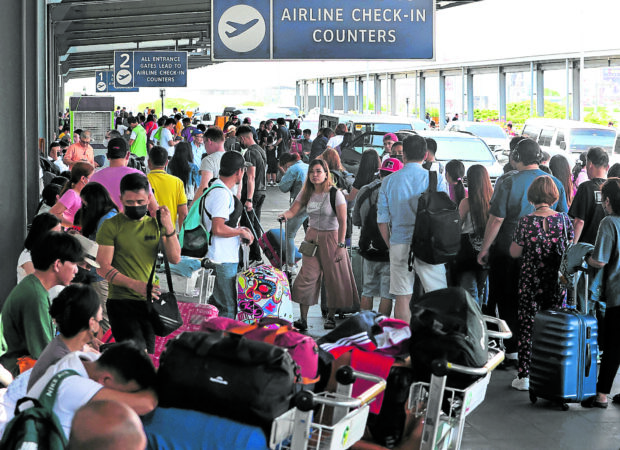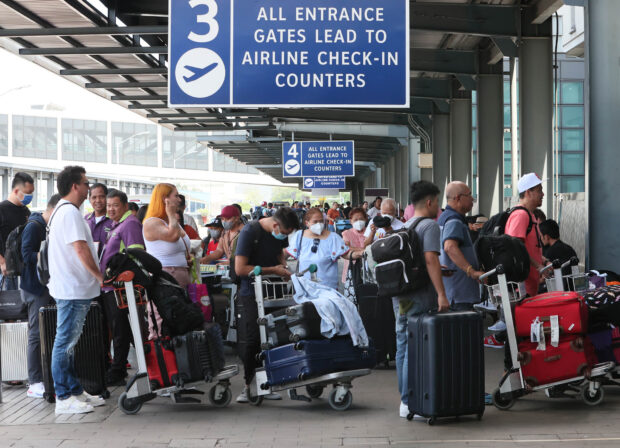8-hour outage hits Naia 3; flights delayed, canceled

AIRPORT CHAOS | Passengers pile up at the Ninoy Aquino International Airport Terminal 3 as flight delays and cancellations greet them on Monday, the Labor Day holiday, due to a power outage that lasted almost eight hours. (Photo by MARIANNE BERMUDEZ / Philippine Daily Inquirer)
MANILA, Philippines — At least 9,391 passengers were affected when several domestic and international flights were either canceled or delayed after a power outage hit the Ninoy Aquino International Airport (Naia) Terminal 3 on May 1, Labor Day.
The power interruption that lasted from 1:05 a.m. to 8:46 a.m. on Monday happened exactly four months after an electricity supply problem on New Year’s Day caused the air traffic navigation system to go offline, shutting down the country’s entire airspace.
In a press briefing, Transportation Secretary Jaime Bautista said that the Manila International Airport Authority (MIAA) turned on its generator sets to partially supply power to “mission-critical facilities,” including security x-rays and baggage carousels.
Standby power was also provided to “critical facilities, enabling computer systems of airlines and immigration to function partially and enable processing of both inbound and outbound passengers,” according to the MIAA.
Some areas, however, were left without lights and air conditioning as the generators could not support the terminal’s total power requirement.
A team from Manila Electric Co. (Meralco) arrived at Terminal 3 about 15 minutes after the start of the power outage. The power supply was restored at 8:46 a.m. and operations went back to normal, Bautista said.
MIAA apologizes
“We sincerely apologize for what happened,” MIAA General Manager Cesar Chiong said at the same briefing. As for the “root cause” of the power outage, he added that they have yet to complete their investigation.
Meralco engineer Noel Espiritu, on the other hand, said that an overflow of current within the airport’s electrical system caused the power outage.
“There was a fault indication at the main circuit breaker of Naia Terminal 3 and it triggered an opening in the main circuit breaker which caused the power outage,” he said, adding that after changing an electrical component, power was restored.
Espiritu said the cause for the overflow of current was still under investigation as another Meralco representative, Aquilino Santiago III, noted that the overflow could have “caused an explosion in the electrical system if the circuit breaker did not function.”
Bautista, meanwhile, said he had asked Gen. Ricardo de Leon, National Intelligence Coordinating Agency director, to conduct an investigation and look into other possible causes, including “sabotage.”
“There are a lot of possibilities and we’re not discounting sabotage. Meralco will also help us assess if there was sabotage so we really need to study that,” he said, pointing out that this was the third power outage to hit Naia since September last year.
Bautista added that they were also considering a full electrical audit of Terminal 3 and the other airport terminals, which would take around 60 to 90 days.
The power outage caused Cebu Pacific to cancel 48 domestic flights going to Tuguegarao, Daraga, Cagayan, Caticlan, Puerto Princesa, Bacolod, Davao, Butuan, Iloilo, Zamboanga and Cagayan, among others.

DISRUPTION | The Ninoy Aquino International Airport Terminal 3 is hit by a power outage on Monday, leading to a disruption of the airport’s operation four months after a glitch shut down the country’s airspace. (Photo by MARIANNE BERMUDEZ / Philippine Daily Inquirer)
Affected passengers were offered free rebooking, ticket refund or travel fund options.
Several flights operated by AirAsia Philippines to Korea, Japan, Cebu and Caticlan, on the other hand, were delayed.
Darkness, heat
One of the affected passengers, Rachel (not her real name), said she arrived at the terminal at 4 a.m. for her 5:50 a.m. flight to Davao and spent over six hours in the dark and sweltering heat.
“I was panicking because we were not immediately given instructions. A lot of people were lining up and we didn’t know what was happening,” said the 24-year-old teacher who was leaving Metro Manila after a short vacation.
“It’s disappointing because my family is expecting me to arrive at the [Davao] airport early and my parents are waiting for me,” she told the Inquirer.
In a statement, the Civil Aviation Authority of the Philippines (Caap) said that it was working with airlines to accommodate the needs of passengers affected by flight cancellations or delays.
“Recovery flights are anticipated to accommodate stranded travelers, and airlines are already assisting passengers with rebooking and refunds,” it said. The MIAA also distributed food and water to affected passengers.
New Year glitch
Monday’s power outage happened after a technical glitch caused by a power supply problem shut down the country’s air navigation facilities on Jan. 1 and grounded nearly 600 flights flying in and out of Naia, affecting around 65,000 passengers.
After conducting some troubleshooting, Caap technicians were able to restore partial operations later that same day with the Communications, Navigation and Surveillance Systems for Air Traffic Management returning to normal mode after almost two hours.
In March, a Senate investigation led by Sen. Grace Poe found that the sudden shutdown of the country’s airspace on Jan. 1 was not due to sabotage or a cyberattack, but the result of “underlying issues” that conflated with decades-old problems faced by Caap.
This raised the need to put up a backup at a different location for Caap’s air traffic management system. While the transportation department earlier said it would be conducting a feasibility study to realize this project, no major developments had been reported since then.
Poe, meanwhile, called the latest incident unacceptable, saying it showed “another disruptive failure of the airport systems causing grave inconvenience to travelers.”
“It seems the [Department of Transportation] and Naia never learned from [their] previous failures,” she added.
Senate Majority Leader Joel Villanueva said the Senate would make sure to hold concerned government authorities accountable, adding that he would talk with Poe about whether or not the latest incident warranted another inquiry.